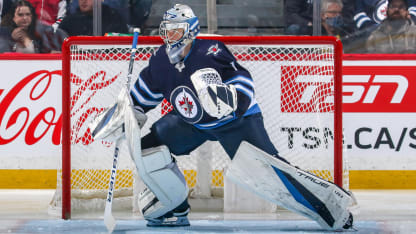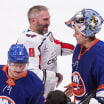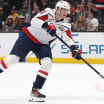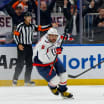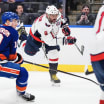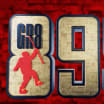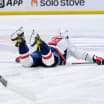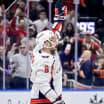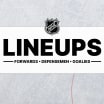The preperiod routine for NHL goalies can be as unique as a fingerprint, in the way they use their skates to scrape up the blue ice in their crease and the reasons for it.
The patterns are also unique, though most generally resemble someone skating in place, legs pumping side to side like a speed skater but without ever moving too far.
For many, it is little more than a habit learned from watching a generation of goalies before them do it, a ritual repeated from a young age with such regularity that they now couldn’t imagine starting a new period without marking up the ice under their feet.
For others, it is more purposeful and measured, a way to warm up the legs, connect with their edges and make sure that ice is optimized for sliding side to side on their pads.
It’s a contrast exemplified in the Seattle Kraken crease.
“There's more to it than just scraping,” Kraken goalie Philipp Grubauer said. “Some rinks leave water on the ice and now with the fast glide [materials on the inside edge of the pads] you’d just slide into the corner. So, you scrape it to stop yourself from sliding too much but also to make it a little bit better to slide because there's a little more snow on the ice.”
For Grubauer’s crease counterpart in Seattle, the preperiod scrape is more of a habit.
“Scraping the ice for me is just a routine,” said Joey Daccord. “Everyone does it, so you just start doing it too, and now it's like a routine and I do it the exact same way every time.”
Daccord, who also mentioned sliding better on ice that has been scraped, starts by going across his crease in each direction. The first pass is close to goal line, followed by another side-to-side scrape closer to the top of crease, staggering them to fill in the middle gap from the first one with the strides of the second. Then he does one scrape up the middle of the crease just passed the top, and one more from the middle out to each face-off dot.
“Same thing every time,” Daccord said.
Grubauer, though, sometimes doesn’t scrape at all to start a period.
“I hate scraping when the crease is still wet because it freezes and then it's like sandpaper and you can't do anything,” he said. “So, I sometimes wait until the first TV time out or I get a towel and just wipe the water down, but some rinks are better than others.”
Grubauer and Daccord aren’t the only ones whose crease scraping routines differ.
Some goalies make long, slow strides from one side to the other, almost like they’re slow dancing compared to the more frenetic techno beat-inspired movements of those who prefer shorter, choppier-looking strides from top to bottom or at angles from the middle.
“It is a good way to get your legs going a little bit,” Chicago Blackhawks goalie Spencer Knight said. “But mostly it’s because you watch NHL games growing up, you see goalies do it, so when you're a kid, you do it too and it's always been something that's part of our routine.”
Some barely scrape the ice or change how the crease looks. Other goalies turn it from a deep blue to a faded, lighter blue with the layer of white scrapings they add to the top.
Eric Comrie’s routine looks a lot like Daccord’s but without the last two scrapes out toward each face-off dot, but he never scrapes the crease before practice.
“It's honestly just a habit for me. I've watched it and done it my whole life before a period, but I don't scrape the crease before practice,” the Winnipeg Jets goalie said. “A wet crease doesn't bother me. I know sometimes a wet crease can be inconsistent sliding because you can get too far, or sometimes it can be sticky, and grab. Sometimes I scrape it up if the ice is sticky, other times you scrape it up when it's too wet, kind to get the right feel.”
But before each period it’s a constant and it’s always the same.
“Always, it’s just my routine,” Comrie said. “I pretty much copied (Montreal Canadiens’) Carey Price’s scrape routine. I saw that when I was younger, so I kind of copied his.”
Comrie’s Vezina Trophy-winning playing partner has a much different routine.
Connor Hellebuyck makes the same two side-to-side passes across his crease as many of his peers, but it’s mostly gliding, and he barely takes any ice off the top of his crease, typically only digging his edges in four times and very briefly compared to others.
“I just nick it, a light touch to make sure there are no like bumps. That's it,” Hellebuyck said. “I put little edges in it, just to make sure I have spots. I don't want to rip across the crease, but I want to know there's a couple spots in it that will slow me down if I need it to.”
Generally, ice left untouched or unscraped can be so smooth that the pad slides too well, too fast, and at the cost of the lateral control most goalies crave. The sliding properties of different ice surfaces can vary from brand to brand of leg pads, and even within brands, depending on the type of material used along the inside edge of each pad. Optimizing that interaction can help, but the reality is most goalies still scrape the crease because they grew up watching the NHL goalies that came before them doing the same thing.
“You do it to scrape up a little water so you don’t slide out of your posts but 30 percent of when I started doing it when I was younger was because I thought it looked cool,” said Edmonton Oilers goalie Calvin Pickard. “I did it because everyone else did it.”
